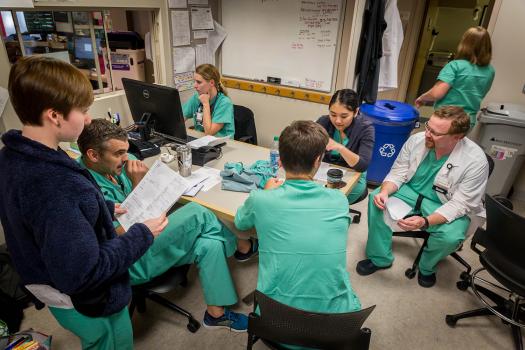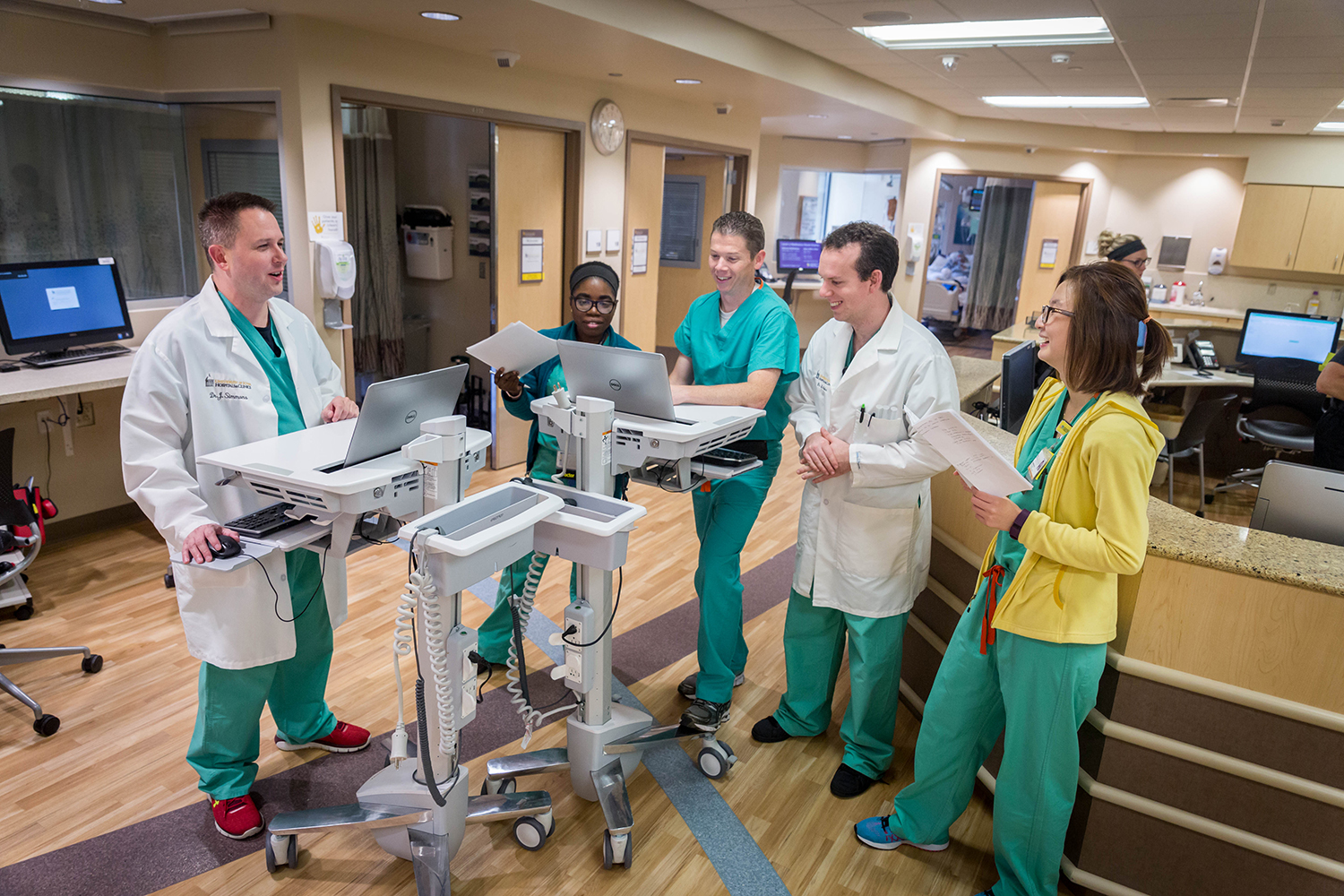PGY-1 (Intern)
The clinical base year in anesthesia at the University of Iowa is structured to prepare you for clinical training in anesthesiology and peri-operative medicine. The goal is to give you a wide exposure to the clinical specialties that will help you take care of your patients while you learn the system at University of Iowa Hospitals & Clinics. This will help you develop collegial relationships with faculty and house staff members on teams you will work with later as an anesthesia resident.
During this year, you rotate through:
- Surgical Neuroscience Intensive Care Unit/Cardiovascular Intensive Care Unit (SNICU/CVICU)
- Pediatric Intensive Care Unit (PICU)
- Emergency Medicine
- Surgery, including:
- Trauma Surgery
- Pediatric Surgery
- Internal Medicine, including:
- Renal consults
- Cardiology
- General medicine
- Palliative Care Medicine
- Either Radiology or Pain Medicine
- Advanced Clinical Medicine
- Safety and Quality
- Anesthesia
- All our interns do their block of anesthesia in June so that the transition to the anesthesia residency is smoother.
The Safety and Quality (SAQ) Rotation is unique at the University of Iowa. It is a required 4-week rotation that was integrated into the internship in 2014-2015.
The goals of the SAQ rotation are:
- Orient trainees to UI Hospitals & Clinics quality, safety, and performance improvement programs
- Teach system thinking through shadowing
- Teach patient safety through relationship building
- Enable empowerment by being agents of change.
Interns participate in activities such as:
- Shadowing:
- SNICU nurses
- MRI technicians
- Emergency Department
- Main OR Pharmacy
- Perioperative Units
- Meeting with hospital safety and quality officers and legal counsel
- Attending meetings of the Safety Oversight Team
- Council on Quality and Safety
- M and M conferences in the Department of Anesthesia and Internal Medicine
- Root Cause Analysis (RCA) and Failure Mode Effect Analysis (FMEA) processes
- Completing the 16 on-line learning modules for the basic certificate of the Institute for Healthcare Improvement.
- This required rotation is novel for anesthesia training programs and provides trainees with uncommon access to hospital leadership concerned with safety and performance improvement.
The Palliative Care Medicine rotation is another relatively unique rotation for anesthesia trainees.
The goals of the Pallivative Care Medicine rotation include:
- Understand the principles of palliative/hospice medicine
- Define and apply effective strategies and techniques for communicating with patients and families (especially when the communication is related to "bad news")
- Identify and apply effective management strategies for non-pain symptoms (for example, nausea, dyspnea, anorexia, delirium and terminal restlessness) in patients at the end of life
- Appropriately prescribe opioid and non-opioid drugs for treatment of pain
- Explore the emotional and psychosocial aspects of the illness experience and physician grief
- Work with patients regarding goals of care.
On this rotation residents develop a close working relationship with the faculty physicians. Residents participate actively in-patient evaluation, management, and education.
During May and June, interns participate in the Advanced Clinical Medicine (ACM) rotation and have their first rotation in Anesthesia. During these two blocks, residents have an orientation to the department, workshops, simulations, and basic lectures on anatomy, physiology, pharmacology, machines/monitors, communications, leadership, and the basics of anesthesia. Faculty from the Department of Anesthesiology and other UI Hospitals & Clinics departments and CA3 residents provide the educational content. Residents also conduct anesthesia in the OR.
| Rotation | Number of blocks | Equivalent number of weeks |
|---|---|---|
| Surgical Neuroscience Intensive Care Unit (SNICU) or Cardiovascular ICU (CVICU) | 2 | 8 |
| Medicine (General Medicine ward, Cardiology, Renal Medicine) | 2.5 | 10 |
| Surgery (Trauma, Pediatric) | 2 | 8 |
| Safety and Quality/EKG | 1 | 4 |
| Advanced Clinical Medicine | 1 | 4 |
| Emergency Medicine | 1 | 4 |
| Palliative Care/EKG | 1 | 4 |
| Pediatrics (PICU) | 1 | 4 |
| Pain Medicine (or Chest Radiology)/EKG | 0.5 | 2 |
| Anesthesia | 1 | 4 |
Surgical Neuroscience Intensive Care Unit

The Department of Anesthesia is committed to the development of anesthesiologists skilled in the practice of critical care. The Surgical Neuroscience Intensive Care Unit/Cardiovascular Intensive Care Unit (SNICU/CVICU) at University of Iowa Hospitals & Clinics has been medically directed by the Department of Anesthesia since the 1970s.
The 40-bed SNICU is a major referral center for support of critically ill patients in Iowa and surrounding states. Typical SNICU patient problems include:
- Trauma
- Post-surgery
- Post-organ transplant:
- Liver
- Kidney
- Septic shock
- Multi-system organ failure
- Peri-operative complications
- Acute neurological injuries
- Head injuries
- Spine injuries
- Stroke
The SNICU is located in close proximity to the main operating rooms and the Critical Care Laboratory, enhancing efficiency of patient care. More than 3,000 patients per year are admitted for care in the SNICU/CVICU.
The CVICU is a combined medical and surgical ICU and located one floor below the SNICU. Anesthesia trainees on this rotation cover only the surgical patients, but are immediately available to help with the management of airways or lines on the medical patients.

In both intensive care units, patient care is directed by board-certified intensivists who are physicians with primary certification in anesthesia, internal medicine, surgery, or emergency medicine. Patient care is provided directly by residents, fellows, and supported by other health care providers, including critical care nurses, pharmacists, respiratory therapists, dietitians, social workers, and physical therapists.
Mid-level practitioners (PAs and ARNPs) work with residents and fellows to facilitate safe, effective, and efficient patient care. The mid-level practitioners help residents with activities such as documentation of patient care (writing notes in the electronic medical record) and writing orders. We believe that close professional relations between specialists and optimal patient care result from this team approach to clinical service and teaching.
The didactic program emphasizes evidence-based practice and includes lectures, mechanical ventilation laboratories, journal clubs, morbidity and mortality conferences. Residents get significant experience in critical care procedures, including emergency airway management, mechanical ventilation, fiberoptic bronchoscopy, echocardiography, and broad aspects of hemodynamic monitoring. With graded levels of responsibility during the training process, residents develop the expertise and confidence to handle any patient care emergency in the OR or in the ICU.